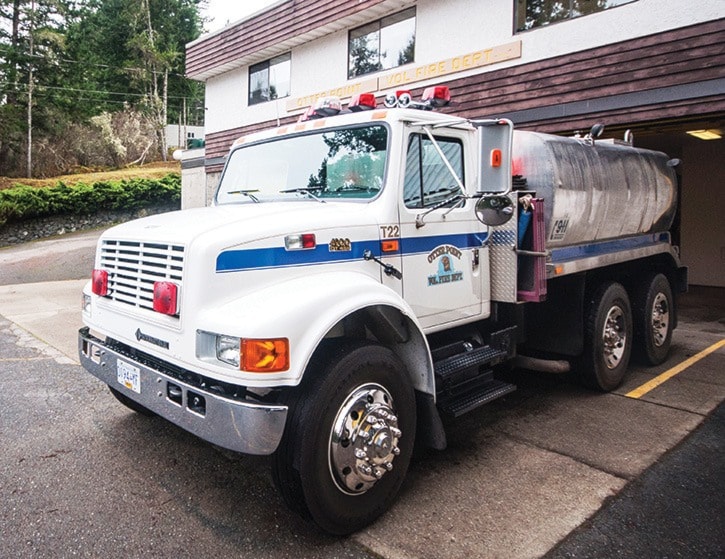During the midnight hours of Tuesday, February 3, 2015, neighbours could hear explosions going off just across the street up in Otter Point; the aftermath of a fire that caught and spread quickly through a local workshop.
Several fire crews arrived on scene - from Sooke, Otter Point, East Sooke and Metchosin - the flames had engulfed the structure, blowing its roof off and consuming its walls from inside out. Despite their hardest efforts to save it however, it was too late.
With the nearest water hydrant being some 2.5 km away from that location, some can't help but wonder: was it a water issue?
"No, there was plenty of water available in dealing with this particular fire," says Otter Point Fire Captain John McCrea, who says the use of tenders - big semi-trucks with a massive water tank in the back - have been sufficient for most fire emergencies in the area.
Tenders vary in size, though the more rural the region, the bigger they are likely to be; for example, Otter Point FD's current tender truck can carry up to 2,200 gallons of water, while Sooke's tender holds 1,400 gallons.
"We already know where the areas are that have no hydrant, so we have a really good tender-shuttle system in place to make sure we always have water," he said. "All our mutual-aid partners are involved in that, so if we have a structure fire or sooke has a structure fire in a non-hydranted area, tenders come in particularly handy."
According to McCrae, after the flames were put out Tuesday night, two tenders were actually sent back to their stations - in other words, there was too much water.
Still, always good to have that extra help than not have it at all, notes McCrae.
"The idea is to get as much manpower and equipment there as quick as possible," he said. "If you don't need it, it's not a huge issue to stand them down, but at least you have the resources coming right away."
Sooke Fire Chief Steve Sorensen says adding extra tenders is all fire departments can do at this point to stay prepared; that, and mutual-aid/automatic-aid agreements.
"Mutual aid is we have a fire in Sooke, I need your help, call Otter Point, I need a tender, an engine, whatever. Automatic aid is when it's pre-established what you want for certain types of calls," Sorensen said.
Direct water access via hydrants remains an issue however; one that, according to Sorensen, won't be resolved anytime soon.
"Right now there's no appetite to develop in rural areas, nor is there any capacity because the sewers don't go that way, which hydrants hinge on to work," he said. "For us it is all about strong mutual aid agreements and calling in tenders."
The luxury of piped city water has to end somewhere though, notes CRD regional director Mike Hicks.
"That's a reality of rural living. The costs of extending the water line to Otter Point or Shirley would be tens of millions of dollars - there's no one around to be able to pay it," he said, adding that most water lines are extended when there's a big development going on.
In this case, also unlikely.
"There are no big developments in Otter Point, and probably there never will be, because the OCP (Official Community Plan) they want to keep that are rural," Hicks said.
Places such as Jordan River don't even have fire service in the area, however the extent of coverage and efficiency for neighbouring fire departments is likely to change.
According to Hicks, Shirley's fire department is in the process of putting in a water tank that can hold tens of thousands of water right beside their fire hall. In addition to that, they will also be installing a pressurized hydrant that will allow tender trucks to hook up and refill very quickly.
